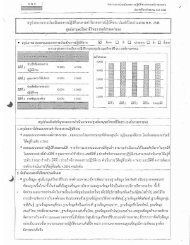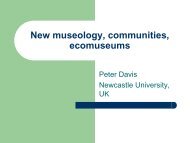Download
Download
Download
Create successful ePaper yourself
Turn your PDF publications into a flip-book with our unique Google optimized e-Paper software.
environments, climates, and available resources. However,when nature threatens normal ways of life in the form ofnatural disasters, such as floods, droughts, and tsunamis,people must devise effective survival methods. In thecase of communities represented by the MahasarakhamUniversity Museum from Mahasarakham province, theperiod before the annual rice harvest was often a timeof flooding and hardship. In order to feed their families,groups of mor lam performers would travel from villageto village, engaging in the “kaw khao” tradition, or “askingfor rice.” Upon arriving in a new village, they staged alively evening show at the local temple. The followingmorning the group would walk through the village, askingcommunity members for uncooked rice as a token ofappreciation for the performance.The Khlong Lat Mayom Floating Market Museumbrought an example of an easy-tomakeboat to the festival.“As spaces for the display andsafeguarding of these histories andidentities, as well as the objectsthey encompass, Thailand’s localmuseums offer us a glimpse ofhow populations from all over thecountry have reacted to both localand national periods of difficulty.”Other museumsdisplayed innovationsthat involved reactingto nature by alteringthe surroundingenvironment or bybuilding vessels suchas boats. SurachaiRunboonrat, whofounded the Khlong LatMayom Floating MarketMuseum in Bangkok, adapted a traditional boat patternand now teaches interested individuals how to maketheir own simple wooden boats that can be constructedquickly in times of emergency. He hopes that hiscourse will counterthe greed of thosewho charge inflatedboat-use fees byencouraging peopleto be more preparedfor flooding, to shareresources, and towork together ascommunities.Communitycohesion was also acritical element of thesecond core idea,“local knowledgeversus sickness andThe exhibition displayinginformation about the “Yao”healing ritualdisease.” To view illness not only as a physical problem isto realize that one’s well-being is closely related to one’sfamilies and communities. As such, the struggle againstillness does not involve the body alone, but requiresemotional treatment and a focus on personal relationships.Furthermore, the methods of care must be founded uponlocal religious and natural beliefs that correspond withthe social context of each locality. Representatives fromthe Phu Tai Renu Cultural Center in Nakhon Phanomillustrated the inextricability of family and community fromlocal healing rituals when they demonstrated the “Yao”ritual. Many members of the Phu Tai ethnic group believethat when an individualfalls ill, an angry ghosthas entered the body,and recovery will not bepossible until the spirithas been ushered outwith soothing entreatiesand prayers. Thus, theYao ritual is performedby local healers andfamily members, whosit with the sick personand sing special songs, beseeching the ghost to leave.At the festival, this theme of the spiritual, intangibledimension of illness was not divorced from biomedicinalapproaches; visitors to the exhibit set up by the Nang7







